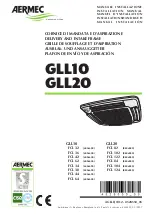
5566020-JIM-C-1019
Johnson Controls Ducted Systems
61
The control circuit includes the following safety controls:
Pressure switch
When the draft motor has reached full speed and closes the
pressure switch (PS) during a normal ignition sequence, if the
pressure switch opens for 2 seconds, the GV is de-energized,
the ignition cycle is aborted, and the ICB flashes the
appropriate code. For information on the ignition control flash
codes, see Table 35 on page 71. The draft motor is energized
until the pressure switch closes or W1 is lost.
Roll-out switch
The roll-out switch (ROS) is wired in series with the pressure
switch. As such, the ICB cannot distinguish the roll-out switch
operation from that of the pressure switch.
Consequently, the control only responds in the same manner
as outlined in
. An open roll-out
inhibits the gas valve from actuating.
Internal microprocessor failure
If the ICB detects an internal failure, it ceases all outputs,
ignores inputs, and displays the proper flash code for control
replacement. The ICB remains in this condition until it is
replaced.
Flash codes
The ICB initiates a flash code associated with errors within the
system, Table 35 on page 71.
Resets
Resets remove the call for heating by lowering the thermostat
setting lower than the conditioned space temperature. This
resets any flash codes.
Gas heat anticipator setpoints
The anticipator setpoint must be correct. Too high of a setting
results in longer heat cycles and a greater temperature swing in
the conditioned space. Reducing the value below the correct
setpoint gives shorter ON cycles and may result in the lowering
of the temperature within the conditioned space. See Table 31
for the required gas heat anticipator setting.
Cooling start-up
Pre-start checklist
When the installation is complete, perform the following checks:
1.
Check the electrical supply voltage being supplied. Verify
that it is the same as the voltage listed on the unit
nameplate.
2.
Set the room thermostat to the off position.
3.
Turn on electrical power to the unit.
4.
Set the room thermostat fan switch to on.
5.
Check the indoor blower rotation.
• If the blower rotation is in the wrong direction, see
Check the blower drive belt tension.
6.
Check the unit supply air (CFM).
7.
Measure the evaporator fan motor's amp draw.
8.
Set the room thermostat fan switch to off.
9.
Turn off electrical power to the unit.
Operating the unit
1.
Turn on electrical power to the unit.
Note:
Before each cooling season, you must energize the
crankcase heaters at least 10 hours before the system
is put into operation.
2.
Set the room thermostat setting lower than the room
temperature.
First stage compressors energize after the built-in time
delay of five minutes.
The second stage of the thermostat energizes the second
stage compressor if needed.
Post-start checklist
1.
Verify proper system pressures for both circuits.
2.
Measure the temperature drop across the evaporator coil.
Gas heat start-up
Pre-start checklist
When the installation is complete, perform the following checks.
1.
Check the type of gas supply. Verify that it is the same as
the gas supply listed on the unit nameplate.
Table 30:Gas heat limit control settings
1
1. Roll-out = 300°F, Auxiliary limit = 200°F.
Unit
Main limit setting
°F
Size
Opt.
J06ZF
N12
165
N18
165
J07ZF
N12
165
N18
165
J08ZF
N12
215
N18
195
J10ZF
N18
195
N24
150
J12ZF
N18
195
N24
160
Table 31:Gas heat anticipator setpoints
Setting, amps
W1
W2
0.65
0.1
















































